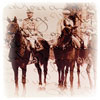George William Cochrane was born in July 1893 in Portage la Prairie, Manitoba. Cochrane enlisted in March 1916 in Winnipeg, Manitoba, with the 196th Battalion. He served overseas with the 46th Battalion and died of wounds April 14, 1917. The collection currently consists of three letters, three photographs, and two newspaper clippings.

Title
WWI
These collections contains any material relating to Canada from 1914 to 1918 from either the home front or the battlefront. External links in collection descriptions are either to online attestation papers at Library and Archives Canada or casualty and burial information at the Commonwealth War Graves Commission.
Lieutenant Robert Grierson Combe, VC, was born in Aberdeen, Scotland, in 1880. He immigrated to Moosomin, Saskatchewan, where he worked as a chemist. He enlisted at Prince Albert, Saskatchewan, in April 1915 [note: there is a discrepancy between his attestation papers which date his enlistment as 1915 and other records which date his enlistment as 1916]. He was killed on May 3, 1917, and has no known grave. He was posthumously awarded the Victoria Cross for his bravery. The collection consists of one letter to his grammar school magazine and his citation for bravery.
Horace Kelvin Conners was born in May 1893 in Montreal, Québec. Conners enlisted in Montreal in June 1915 and served overseas with the 60th Battalion until he was demobilized and returned to Canada in 1919. The collection currently consists of five letters, as well as numerous postcards and photographs. See also the collection of his brother, Robert John Conners.
Robert John Conners was born in Montreal, Québec, in October 1890. Conners enlisted in Montreal in January 1917 and served in France with the Broad Gauge Railway Operating Company. He was demobilized and returned to Canada in 1919. The collection currently consists of one letter and two photographs. See also the collection of his brother, Horace Kelvin Conners.
Allan Matheson Conquergood was born in Kincardine, Ontario, in May 1872. He enlisted in July 1916 in Winnipeg with the 239th Battalion, the Railway Construction Corps, and served overseas. The collection currently consists of his diary from 1917.
Alfred Frank Cook was born in Midland, Ontario, in August 1894. Cook was a law student who enlisted in August 1915 in Niagara, Ontario, with the 58th Battalion. He served overseas with the 58th Battalion until 1918 when he transferred to the R.A.F. as a flight cadet. He was found to be medically unfit and was discharged and returned to Canada at the end of the war. The collection currently consists of thirty eight letters.
Arthur John Cook was born in Chelmsford, England, in 1892 and immigrated to Canada prior to the war. Cook enlisted in Edmonton, Alberta, in November 1914. He served overseas until the end of the war. The collection currently consists of his 1918 diary and one photograph.
Private Harold William Cooper was born in Merton, Surrey, England, on June 4, 1896, to parents John and Annie Cooper. Prior to enlistment the Cooper family was living in Moosomin, Saskatchewan.
Cooper enlisted with the 10th Canadian Mounted Rifles at Moosomin, Sask., on December 18, 1914. In May 1916 he proceeded to England with the 10th C.M.R. aboard the SS Olympic, and then in September to France where he joined the Canadian Corps Cavalry Regiment (redesignated the Canadian Light Horse in February 1917).
After several months spent in England recovering from gas poisoning, Cooper returned to France in the spring of 1918 where he joined the Fort Garry Horse. He was killed on October 9, 1918, when he was hit by machine gun fire in action near Le Cateau, France. In the final weeks of the war, following Cooper’s burial, the front lines shifted, and his grave site and remains were lost. Cooper is commemorated on the Vimy Memorial, France.
Harold Cooper’s younger brother Private Sidney Frank Cooper also served in WWI with the 10th Canadian Mounted Rifles.
Content notes:
The collection’s only photo is of Pte. Harold Cooper in Service Dress uniform.
External links:
Private Harold Cooper’s service record (Serv/Reg# 115056) can be viewed/downloaded in pdf format through Library and Archives Canada.
WWI Circumstances of Death Registers record card (page #597), Library and Archives Canada.
Burial information is available at the Commonwealth War Graves Commission.
A memorial page honouring Cooper can be visited online at the Canadian Virtual War Memorial.
Private Sidney Frank Cooper was born in Mitcham, Surrey, England, on January 4, 1898, to parents John and Annie Cooper. At the time of Sidney’s enlistment his family was living in Moosomin, Saskatchewan.
Cooper enlisted as a Bandsman with the 10th Canadian Mounted Rifles at Sewell Camp, Manitoba, on July 28, 1915. In May 1916 he proceeded to England aboard the SS Olympic and then in September to France where he joined the 27th Battalion Canadian Infantry. Following the Armistice agreement that brought an end to armed conflict, Cooper returned to Canada aboard the SS Aquitania and was demobilized on May 27, 1919.
Sidney Cooper’s older brother also enlisted in WWI with the 10th Canadian Mounted Rifles. Private Harold William Cooper was killed in France on October 9, 1918.
Content notes:
The collection’s only photo is of Pte. Sidney Cooper with (mascot?) bear cub. Also included is the 1915 Christmas greetings of the 10th Canadian Mounted Rifles.
External links:
Pte. Sidney Cooper’s service record (Serv/Reg# 155600 (orig.# 115591)) can be viewed/downloaded in pdf format through Library and Archives Canada.
Lieutenant Arthur Harold Madill Copeland was born in Winnipeg, Manitoba, on August 27, 1889. Prior to his enlistment in WWI he was a Lieutenant with the Militia’s No. 6 Canadian Army Service Corps (C.A.S.C.), Winnipeg. He enlisted for Overseas Service with the C.A.S.C. on March 8, 1915.
Beginning in March 1916, Copeland served in France with the C.A.S.C. in the 1st and 3rd Canadian Cavalry Brigade Ammunition Supply Parks. In August of 1916 he was attached to the Royal Flying Corps (R.F.C.) (technically remaining a Canadian officer, but working as a member of the British R.F.C.).
While serving as a gunner, Copeland’s plane was shot down after returning from a bombing raid; he was wounded and captured as a Prisoner of War on October 10, 1916. After a period of hospitalization to recover from gunshot wounds to his arm and leg he was transferred to the German P.O.W. Camp at Douai. Over the following two years he was moved frequently, first to Wahn bei Coln, then to Stettin, Stralsund Danholme Pommern, Augustabad bei Neubrandenburg, Schweidnitz Selesia, Holzminden, Mainz, and finally to Holzminden again.
While in captivity he was appointed to the temporary rank of Captain (a rank he kept until the end of his service). He was later “Mentioned in Reports for valuable services while in captivity, and noted accordingly in the Official Records of the Air Ministry" in the London Gazette on December 12, 1919 (see external links below). Copeland had escaped and been recaptured twice while a P.O.W. and the “valuable services” mentioned in reports may have been related to either his own escape attempts or for providing assistance to similar attempts by others.
Following his release and repatriation to England on December 14, 1918, Copeland returned to Canada and was demobilized on March 23, 1919.
The letters in the Copeland Collection were all written to Hilda R. Lailey of Toronto while Copeland was held as a German P.O.W. (following the war she became his wife; they were married for sixty-four years). With the exception of the last letter, which was written after the Armistice of Nov. 11, 1918, the letters and envelopes bear a variety of P.O.W.-related stamps indicating the content of the letters was monitored by the Germans (e.g. the first page of the letter of Nov. 14, 1916, bearing the red stamp “Geprüft. Kommandantur Wahn-Lager 63,” which roughly translates as “Checked. Headquarters Wahn-Camp 63.” The “London F.S. PAID” postmarks on the envelopes are those of the London Foreign Service.
Included in the collections “Other” contents listed below are two German documents; titled “Gefangenenlifte des Lagers,” these are pages from Prisoner Lists of the Camps, one for Wahn (western base) in January 1917, and one for Holzminden in April 1918.
The newspaper article is from the Y.M.C.A.’s wartime publication Canadian Manhood, of Jan/Feb 1917.
External links:
Lt. Copeland’s service record (Serv/Reg# not assigned) can be viewed/downloaded in pdf format through Library and Archives Canada.
Copeland’s commission as a Lieutenant was published in The London Gazette on February 2, 1916 (#29480, p. 1897), and he was “Mentioned in Reports” on December 12, 1919 (#31691, p. 15613).
Ernest Corbett was born in Orangeville, Ontario, in February 1893 and later resided in Wellington, British Columbia. He enlisted in Moose Jaw, Saskatchewan, in March 1916 and served overseas with the 1st Canadian Mounted Rifles. Corbett was killed August 21, 1917. The collection currently consists of one letter and one photograph.
John Andrew Corcoran was born in Charlottetown, Prince Edward Island, in August 1886. Corcoran enlisted in Vancouver in January 1916 with the 102nd Battalion. He served overseas, was wounded in August 1918 and was demobilized back to Canada in 1919. The collection currently consists of twenty-seven letters as well as photographs and miscellaneous items related to his servce.
Arthur Donovan Corker, MM, was born in February 1894 in Victoria, British Columbia. Corker enlisted in September 1914 and was part of the First Canadian Contingent. He was serving with the 7th Battalion when he was taken prisoner during the Second Battle of Ypres on April 24, 1915. As a prisoner, Corker attempted to escape six times, was recaptured, and finally succeeded in his seventh attempt in 1918. The collection consists of one letter written shortly after he made his escape to Holland. As well, Corker did an interview in 1983 describing his escape, which is part of the University of Victoria archives. To listen to Corker, click here.
William Hubert Corrigan was born in Brandon, Manitoba, in July 1881. Corrigan enlisted in Regina, Saskatchewan, in May 1916 and served overseas with the 217th Battalion and the 209th Battalion, after having served the previous seven years with the 90th Winnipeg Rifles. He was demobilized and returned to Canada at the end of the war. The collection currently consists several photographs and postcards from his time overseas.
Frank Clifford Cousins was born on October 24, 1893, in Belmont, Ontario. He began his university studies at the University of Toronto in 1911, and then moved west to the Regina area where he taught school and attended university. Cousins enlisted in Regina, Saskatchewan, in July 1917 and arrived in England in December of that year. In April 1918 he was sent to France where he took part in the Battle of Amiens in August. Later that month he was wounded and sent to England for surgery and to recuperate, and remained in England until the end of the war. Upon returning to Canada he resumed his teaching and his university studies, received his L.L.B. in 1924, and was called to the bar in 1926. He was a partner with the future Prime Minister John Diefenbaker in the firm of Diefenbaker, Cousins & Godfrey. Frank Cousins died in his sleep in June 1927. This collection consist of ninety letters and other miscellaneous materials.
John ("Jack") Arthur Cowles was born in Oxford, England, in March 1893. He was a member of the Balliol Boys Club, a club run by the students, graduates, and tutors of Balliol College in Oxford. It was under the Club's auspices that Jack came to Canada in 1913. Jack enlisted with the Canadian forces in Saskatchewan in 1914. Cowles served overseas with B Coy. 28th Battalion and he was killed June 6, 1916. The collection consists of several letters to his sister and to the Balliol Boys Club, three postcards, four photographs, and a letter of condolence from Sam Hughes.
Gunner Bertram Howard Cox was born in Barbados on December 13, 1894, to parents Charles Henry and Isabel Cox. He immigrated to Canada prior to the war and was working as a bank clerk in Winnipeg, Manitoba, at the time of his enlistment there with the 59th Overseas Battery, 15th Brigade, on March 26, 1916.
He shipped out to England in September 1916, where he was transferred to the 60th Battery, 14th Brigade C.F.A., and was sent over to France in August 1917. He remained with the 60th until the end of the war and was demobilized on June 28, 1919.
The collection consists of nearly forty letters written by Bertram to family and friends between 1916 to 1919. The majority are addressed to: his parents, his two brothers Carl (and wife Mabel) and Murrill (and wife Ella), and his sisters Ina and Leila (and husband Jack).
Also included is a transcription of the 1917 Christmas edition of the trench-newspaper The O’Pip, published “Somewhere in France” by the 58th Battery C.F.A. The paper was enclosed with a letter sent by Bertram to his sister Leila on January 11, 1918. (It has been posted below under the content category of “Newspaper Articles”)
External links:
Gunner Bertram Cox’s service record (Serv/Reg# 327964) can be viewed/downloaded in pdf format through Library and Archives Canada.
Please note: all letter transcriptions, including annotations to the letters, were provided by the donor.
Private David Craig was born August 17, 1895, in Wick, Scotland, to parents David M. and Jane Craig. He was one of four children in the family.
Craig enlisted with the 74th Overseas Battalion in Toronto, Ontario, on July 28, 1915, and proceeded overseas to England aboard the SS Empress of Britain in March 1916. From there he was sent to France the following June, where he was transferred to the 5th Canadian Mounted Rifles. Craig was serving with that battalion when he was killed at the Battle of Passchendaele on October 30/31, 1917. His body was never found. He is commemorated on the Menin Gate in Ypres, Belgium.
Content notes:
The collection’s main item is the Memorial Cross received by Craig’s mother following his death on active duty.
External links:
Pte. David Craig’s service record (Serv/Reg# 135121) can be viewed/downloaded in pdf format through Library and Archives Canada.
WWI Circumstances of Death Registers record card (page #67), Library and Archives Canada.
Burial information is available at the Commonwealth War Graves Commission.
A memorial page honouring Craig can be visited online at the Canadian Virtual War Memorial.
Jack Crawley was born in Winnipeg, Manitoba, in October 1893. He enlisted in December 1914 in Brandon, Manitoba, and served overseas with the 1st Canadian Mounted Rifles. Crawley was killed June 5, 1916. His photograph is also a part of the Perry Sanderson collection. Sanderson mentions him in his letters; he was killed one day after Crawley. The collection currently consists of one photograph.
Frank Cronk Smith, MC, was born in Brockville, Ontario, in May 1891. He enlisted in Toronto in February 1916 with the 169th Battalion. Cronk served overseas with the 169th and the 20th Battalions, was wounded in August 1918, and demobilized and returned to Canada in 1919. The collection currently consists of one photograph, his officer commissions, a Christmas card, and copy of the Canadian Daily Record from December of 1918.



